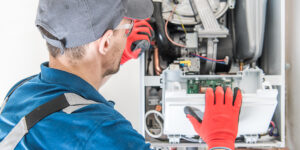How Often Should Furnace Cycle in the Winter?
 How often should a furnace cycle in the winter? We spend more time at home during the winter months, trusting our furnaces to keep us warm on cold days. You might hear your furnace turning off and on during the day — we call that process the heating cycle.
How often should a furnace cycle in the winter? We spend more time at home during the winter months, trusting our furnaces to keep us warm on cold days. You might hear your furnace turning off and on during the day — we call that process the heating cycle.
Is that normal? Yes and no. Cycling is normal furnace behavior, but some patterns of cycling can be signs that the furnace is having problems.
Davis Home Services, a Cherry Hill HVAC company with two decades of experience, wants you to understand your furnace better. We want our customers to be aware of the health of their furnaces so that they can solve problems before they lead to serious damage or dangerous loss of heat in the winter.
Why Do Furnaces Cycle?
A furnace should not be operating continuously for long periods. The continuous operation of your furnace will wear out the motor and cause the furnace to overheat. In normal operation, the furnace will turn on if the temperature is too low and then turn off for a while once the house reaches the right temperature.
After a while, the temperature will fall back down as heat radiates from the house. This should happen gradually. The furnace will then come back on again and repeat the process.
If you change the temperature setting on the thermostat, it will turn on or off until it reaches the desired temperature.
How Often Should a Furnace Cycle?
The honest answer to this question calls to mind the old joke, “How long should your legs be?”
“Long enough to reach the ground.”
The furnace should cycle as often as necessary to keep the temperature constant in your home. In practice, this means that the furnace should cycle every 20 minutes or so throughout the day. However, many variables could influence how long a furnace should cycle.
If you are concerned about the behavior of your furnace, look for other problems, such as noises, odors, and inconsistent heating.
Why Might a Furnace Cycle Abnormally?
A furnace could cycle too rapidly if the furnace is having trouble maintaining an even temperature. Alternatively, if a furnace runs for too long before cycling off, that could mean that it is struggling to maintain its target temperature. Many problems can cause abnormal cycling.
The Thermostat
The thermostat tells the furnace whether the air temperature is too low or too high. If the thermostat is not calibrated correctly or the heat sensor is broken, the furnace might try to run continuously or cycle more frequently.
The Size of the House
If a furnace is too big or too small for the house, it might have an abnormal cycle as it tries to keep the temperature steady. The furnace will struggle if it is not the right size furnace.
If the house is too big, it might be able to heat one part of the house but not more distant parts. If the house is too small, the furnace might heat too quickly and have difficulty keeping the temperature even. This can cause the furnace to cycle more rapidly.
The House Insulation
If the house is drafty, has old windows, or has inadequate insulation, your furnace might be struggling to keep up with heat loss. Windows, walls, and doors can be sources of heat loss. Addressing this problem could extend the life of your furnace and decrease your energy bill.
Combustion Within the Furnace
Gas furnaces depend on an optimal mixture of fuel and air. If your furnace does not have an adequate fuel supply or adequate airflow, it might not be able to heat the air effectively. The furnace may run too long to compensate for its inability to burn fuel efficiently.
Incomplete combustion will lead to the buildup of combustion byproducts in the combustion chamber, high heating bills, and possibly a decrease in air quality if fumes from the furnace reach the rest of the house.
The Pilot Light or Pilot Light Sensor
Modern furnaces are designed to shut off as a safety feature if the pilot light is not lit to prevent gas from filling the house. If the pilot light sensor is not picking up the pilot light or the pilot light is not burning properly, the furnace might shut down frequently.
Fixing Problems That Cause Abnormal Cycling
Just as important as the question “How often should a furnace cycle in the winter?” is “How can we make it easier for the furnace to heat the house it’s in?” Once you figure out the problem, there are many potential solutions. Some of them are quick fixes to the furnace, while others are major home improvement projects.
- Turning the thermostat down
- Calibrating and inspecting the thermostat
- Replacing damaged components
- Cleaning out the furnace
- Installing a new, more efficient furnace
- Getting new windows
- Adding insulation to the house
If a problem with your furnace requires a repair or replacement, consider it an investment in your home. A new furnace or heating system can attract buyers and add to the resale value of your home.
So how long should a furnace cycle in winter? The answer can say as much about the house and the environment that the furnace is in as it does about the furnace itself.
The Importance of Professional Furnace Maintenance
If you call up a professional HVAC or heating technician and ask, “How often should a furnace cycle?” they’ll probably want to see your house first before giving a definitive answer. Having your furnace checked out every year in the fall before the temperatures get cold will help to give you a sense of what is normal and what is a cause for concern.
If your furnace is not working right, call the furnace service experts in Cherry Hill for help with the question “how often should a furnace cycle?” and any other furnace question you might have. We’ll send a qualified and diligent furnace repair technician out to inspect your furnace and fix the problem. Call 844-226-9872 to schedule an appointment today.

